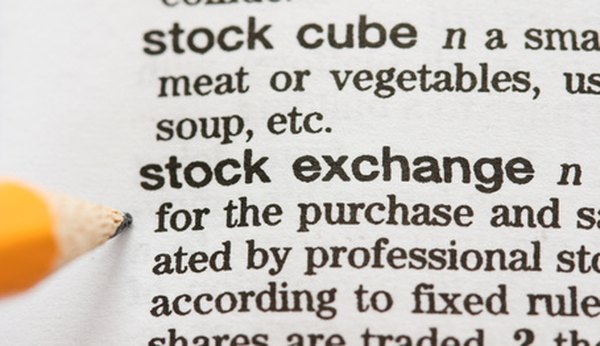NASDAQ vs. New York Stock Exchange
The NASDAQ and the NYSE are two examples of a stock exchange.
stock exchange image by Christopher Walker from Fotolia.com
The New York Stock Exchange and the NASDAQ are businesses where stocks are bought and sold and trading transactions are managed by licensed professional brokers. Each exchange represents a portfolio of companies and measures its portfolio's performance through the indexing process. The major differences between the two exchanges are the way in which the trading process is facilitated and the types of companies each exchange trades.
Tip
The primary differences between these two exchanges are the types of companies that are featured and the specific means for purchasing shares.
Introducing the NYSE
The New York Stock Exchange is the largest and oldest stock exchange worldwide. Although the NYSE moniker was first officially used in 1863, its company foundation began with an agreement created in 1792. The NYSE was initially created as a membership-only organization that allowed firms to trade their stock only by purchasing a seat on the exchange. The number of seats, or licenses, available grew over the years and were finally limited to 1,366.
Initially the NYSE operated a live trading floor on Wall Street in New York City, where trading occurred in-person during set hours of operation. In 2006 the NYSE reversed its membership-only requirement and opened the trading floor to public trading and implemented an electronic trading process.
Exploring the NASDAQ
NASDAQ stands for "National Association of Securities Dealers Automated Quotation"; it as created in 1971 by the National Association of Securities Dealers as a transparent and computerized system for market maker firms to use when buying and selling stocks. Used initially as a trading technology that allowed growth companies to raise capital through stock trading, the NASDAQ separated from the NASD in 2006 and became its own national securities exchange.
Understanding the Trading Process
The NYSE operates as a physical trading company, where floor traders, also known as floor brokers, complete transactions through an auction process. Each floor trader works with a particular portfolio of companies; investors, or investor representatives, contact the floor trader via telephone or electronically and input their trading request. The NASDAQ is a telecommunications network. Unlike the auction process, which may take hours to complete, investors enter their NASDAQ trade requests through an electronic system that processes the trade immediately.
Assessing Traded Companies
The NYSE typically trades traditional companies with a long history of stability and conservative business practices. Companies such as Coca-Cola, General Electric, American Express and IBM are examples of stocks traded on the NYSE. The index known as the Dow Jones Industrial Average, often referred to as the Dow, shows the daily average value of the stocks traded on the NYSE.
The stocks traded on the NASDAQ include technology giants such as Intel, Microsoft and Oracle and companies that are referred to as growth businesses. The NASDAQ Composite is the index used to identify the average stock value traded on the NASDAQ exchange.
Evaluating Listing Requirements
Both the NASDAQ and the NYSE have standard requirements a company must meet before its stock is accepted for trading. The standards are similar for the two exchanges and include requirements such as meeting the minimum number of years of operating history, initial stock price criteria and a minimum earnings threshold. However, there are details within requirements that could make one or the other exchange more suitable for a company.
The NYSE requires a company have in place an internal audit function that continually assesses the internal controls and risk management of the business. The NASDAQ does not require an internal audit function. The NYSE also requires its accepted companies to have and follow corporate governance guidelines and publish those guidelines on the company's website. The NASDAQ does not include a similar provision in its requirements.
References
Resources
Writer Bio
Alex Burke holds a degree in environmental design and a Master of Arts in information management. She's worked as a licensed interior designer, artist, database administrator and nightclub manager. A perpetual student, Burke writes Web content on a variety of topics, including art, interior design, database design, culture, health and business.

